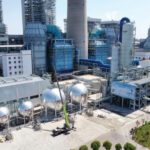Power plant emissions of sulfur dioxide (SO2) and nitrogen oxides (NOx) in the U.S. declined to their lowest level since 1990, the Energy Information Administration (EIA) said in early March.
Emissions of the pollutants from the power sector have steadily been dropping since enactment of the Clean Air Act Amendments in 1990, which established a national cap-and-trade program for SO2 and required other controls for NOx emissions from coal-, gas-, and oil-fired power plants. The program was begun to address concerns about acid rain affecting areas downwind of plants emitting these compounds. It provides economic incentives for coal-fired plants to reduce emissions by installing pollution controls and burning lower-sulfur coal.
But the decline can also be attributed to the Environmental Protection Agency’s (EPA’s) 2005-instituted Clean Air Interstate Rule (CAIR), the EIA says, a rule and several proposed alternatives that have been challenged in the courts. In late 2008 the U.S. Court of Appeals for the D.C. Circuit vacated CAIR, but after the EPA finalized the Cross-State Air Pollution Rule (CSAPR) on July 6, 2011, to replace CAIR, the court on Aug. 21, 2012, issued an opinion overturning CSAPR. The EPA later filed—and the federal court denied—a petition seeking an en banc rehearing of the divided decision. CAIR remains in place and states and affected sources are expected to comply with the rule.
The EIA estimates that since the EPA finalized CAIR, 91 GW of coal-fired power capacity has been retrofitted with flue-gas desulfurization (FGD) technology between 2005 and 2011. The EPA estimates 58% of coal units included in the Acid Rain Program, by percentage of total capacity, had installed FGD scrubbers in 2012, while 41% had installed selective catalytic reduction technology. About 9% had installed selective noncatalytic reduction technology. Virtually all coal-fired units had electrostatic precipitators, baghouses, or advanced controls for removal of fine particulate matter.
Other state requirements and federal settlements under the Clean Air Act’s New Source Review program apparently increased coal plant environmental retrofits. "The Mercury and Air Toxics Standards, issued in 2011 and set to take effect in 2015, do not directly regulate SO2 or NOx but the standards should lead coal-fired power plants to install equipment that further limits SO2 emissions," the EIA says.
An often overlooked factor in the lowered SO2 and NOx emissions from the power sector is the lower overall generation from coal in 2012, as well as historically low gas prices, which contributed to shifting some generation from coal to natural gas.
In December 2012, the EIA reported that coal-fired power plants generated 1,517 TWh of the nation’s total 4,054 TWh, compared to 1,933 TWh of coal power generation in 2002 (of a total 3,858 TWh). Coal-fired generation reached a peak of 2,016 TWh in 2007 (of a total 4,157 TWh).
Coal generation made up a 40% share of the nation’s total generation portfolio in December. In April, that share had fallen to a historical low of 33%—almost equal to the share of power generated by plants fired with natural gas. Natural gas–fired power plants comprised a 25% share of the nation’s generation in December 2012.
—Sonal Patel is POWER’s senior writer (@Sonalcpatel, @POWERmagazine).
This article was first published in POWERnews March 7.








